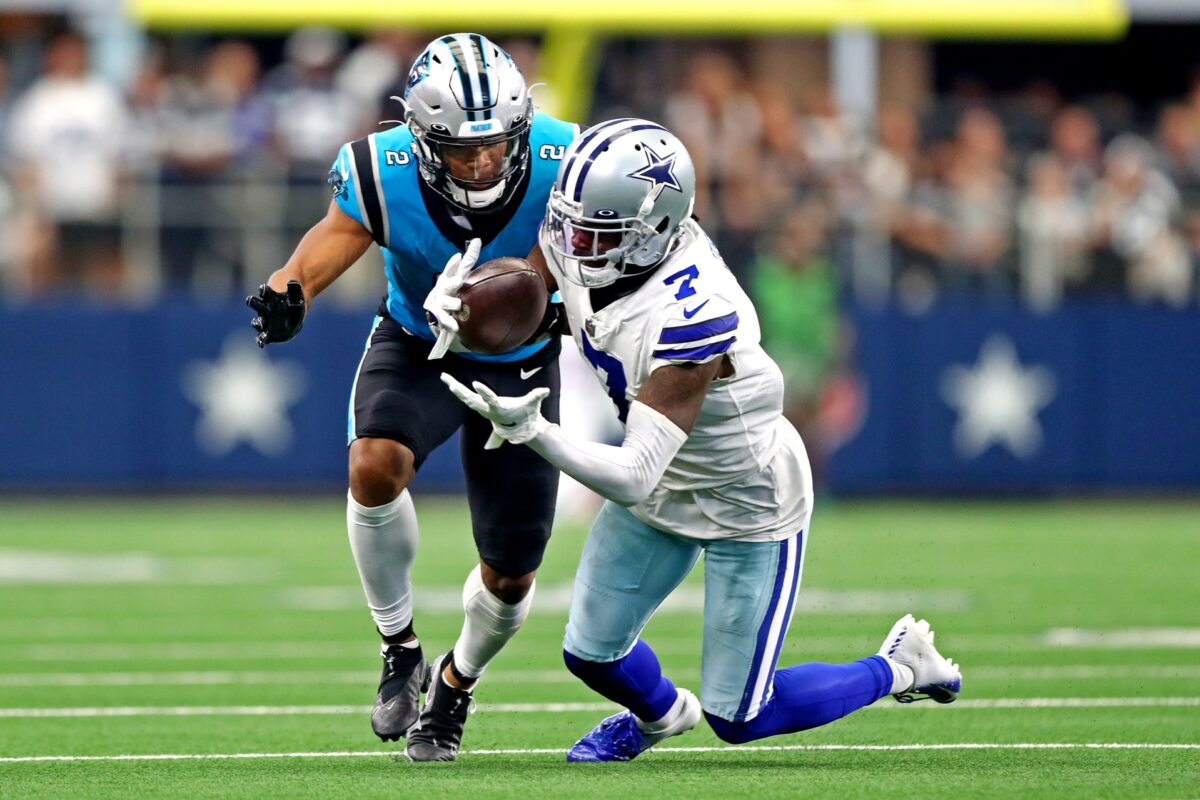Coming from University of Alabama, Trevon Diggs is accustomed to playing in the spotlight.
So maybe we shouldn’t be surprised that he hasn’t been overwhelmed on the big stage with the Dallas Cowboys. Four games into his second pro season, Diggs leads the NFL with five interceptions. In addition to his three picks in 12 games last year, he now has eight in his first 16 professional games.
Few predicted that Diggs would be playing this well, considering the Cowboys ranked 28th in the NFL in points allowed last season. So far this year, Dallas ranks 16th in the league in points allowed.
Meantime, defensive coordinator Dan Quinn has been putting Diggs into positions where he can succeed this season. Every level of the Cowboys defense boasts extremely good athleticism. Rookie linebacker Micah Parsons can rush the passer or drop back in coverage effectively. Veteran linebacker Jaylon Smith possesses impressive speed at the second level, and safety Damontae Kazee is great in coverage.
With all that in mind, let’s go to the tape and examine how the Cowboys are using Diggs.
Every week, Diggs lines up against the X receiver, who is usually the top playmaker out of a team’s receiving corps. So in Week 1 against the Tampa Bay Buccaneers, Diggs was lined up across from Mike Evans.
On this play, it’s all heads up by Diggs. He watches the offensive line running upfield and sniffs out the screen.
Diggs relied on his eyes, liked what he saw and attacked. However, this strategy almost got him in trouble later in the game against Evans.
On the play above, Evans runs a comeback route. But it’s Tom Brady’s last read, so since Evans already made his break toward the ball, he decides to cut back upfield to get open. Diggs already had tried to jump the route and appeared to be beaten on the play. Fortunately for Diggs, his length saved him. Diggs is 6-foot-1 with 78–inch (which ranks in the 90th percentile for defensive backs), and he was able to stretch, recover and get the pass breakup.
In Week 2 against the Los Angeles Chargers, Diggs covered Keenan Allen when the Cowboys lined up in man coverage. As you’ll see below, Diggs has a knack for jumping routes.
To this point, Cowboys opponents haven’t seemed to adjust to Diggs’ performances from week to week. Instead, the Eagles and DeVonta Smith were the next victims of Diggs in man coverage.
At the top of your screen, Diggs is one-on-one against Smith, his former college teammate. Presumably, they know each other pretty well from practice at Alabama, and Diggs won this battle with size and competitiveness.
If the Eagles had focused on how Diggs covered Evans in Week 1, they would have noticed how Diggs loves to jump routes. Any wheel route or double move would have a chance to beat him deep. However, the Cowboys are doing everything possible to force these battles.
By Week 4, the Cowboys and their defensive line have shown a lot of progress in terms of applying pressure to the quarterback. With the drive on the line, Diggs is lined up across from Carolina Panthers wideout DJ Moore on the outside.
On third down, the Cowboys leave Diggs off coverage at the bottom of the screen, which gives him time to read the play. Diggs gets another interception off a curl route.
The next time the Panthers got the ball, they used a stacked lineup on the outside, which sometimes forces the defense to switch. Instead, the Cowboys just place Diggs in the middle of the field to sit in zone coverage.
Unfortunately for the Panthers, the coverage allowed Diggs to sit back and wait for his opportunity.
Because the Cowboys generate pressure up front and possess speed in the back, it’s hard to get their defense off balance. In man coverage, they can keep up downfield. In zone coverage, they bring different looks to force quarterbacks into bad throws underneath.
It’s up to the offense to create mismatches against Dallas and take chances deep.











